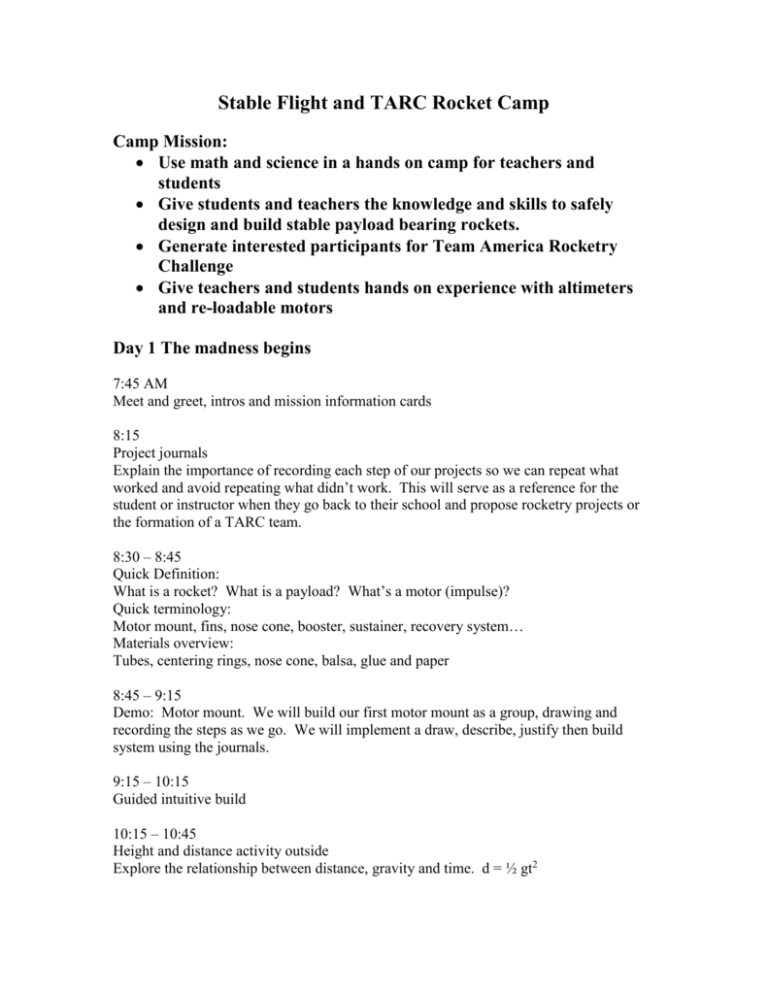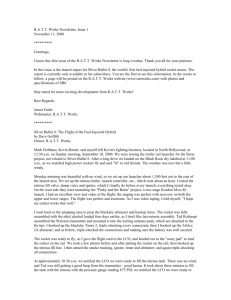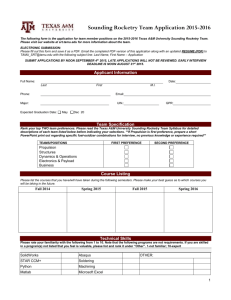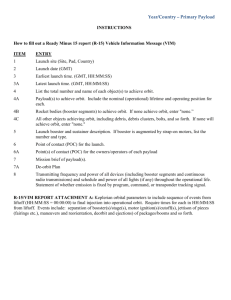Stable Flight and TARC Rocket Camp - Noyce
advertisement

Stable Flight and TARC Rocket Camp Camp Mission: Use math and science in a hands on camp for teachers and students Give students and teachers the knowledge and skills to safely design and build stable payload bearing rockets. Generate interested participants for Team America Rocketry Challenge Give teachers and students hands on experience with altimeters and re-loadable motors Day 1 The madness begins 7:45 AM Meet and greet, intros and mission information cards 8:15 Project journals Explain the importance of recording each step of our projects so we can repeat what worked and avoid repeating what didn’t work. This will serve as a reference for the student or instructor when they go back to their school and propose rocketry projects or the formation of a TARC team. 8:30 – 8:45 Quick Definition: What is a rocket? What is a payload? What’s a motor (impulse)? Quick terminology: Motor mount, fins, nose cone, booster, sustainer, recovery system… Materials overview: Tubes, centering rings, nose cone, balsa, glue and paper 8:45 – 9:15 Demo: Motor mount. We will build our first motor mount as a group, drawing and recording the steps as we go. We will implement a draw, describe, justify then build system using the journals. 9:15 – 10:15 Guided intuitive build 10:15 – 10:45 Height and distance activity outside Explore the relationship between distance, gravity and time. d = ½ gt2 10:45 to lunch (11:45) Guided intuitive build 11:45 – 12:30 PM Lunch 12:30 - 2:15 Discuss recovery and finish intuitive build 2:15 to 2:30 Launch pad safety, protocol and order, pad determined by color sticker on launch card and order determined by the number on launch safety card. 2:30 Put on the sunscreen and walk out to the launch pads By 3:00 start the launches Launch and recover 50 + rockets 4:45 Walk back to the classroom 5:00 – 5:15ish Debrief and record. What worked? What didn’t work? What information would be helpful? Assign days review questions. Clean up! Day 2 Using Math and Science to design a stable model rocket 8:00 AM Day 2 mission cards review questions from day 1 8:25 – 8:50 Math and physics concepts F = ma defined (Newtons 2nd law) and calculated. Predicting velocity and altitude through calculation. Ft = mΔv derived to Ft/m = Δv vave = vf – vi / 2 and d = vavet Using the formulas and guided instruction on entering them into the calculator. 8:50 – 9:00 Applying this to our rockets and payload 9:00 – 9:45 Building a new booster motor mount and airframe Model Rocketry Project step 1 and 2 Area of a cylinder A = 2πh 9:45 -10:00 Center of gravity and center of pressure Model Rocketry Project step 3 10:00 – 10:40 Explain, design and cut fins including Cg and Cp Model Rocketry Project step 4 Area of a triangle A = ½ bh and a trapezoid A = (L1+L2/2)h 10:40 to 11:15 Attach fins: Model Rocketry Project step 5 Circumference and division 11:15 to 11:40 Recovery system and attach Model Rocketry Project step 6 Lunch 11:40 to 12:15 12:30 -1:15 Building launch controller 1:15 to 2:15 Finish build: Nose cone A = rs Pre-launch prep Model Rocketry Project step 7 and 8 Fill out launch cards and predict values A few well built early finishers will be allowed to install PicoAlt altimeters for conformation of altitudes. 2:15 Walk to the launch pad By 2:30 start the launches Launch and recover 50 + rockets 4:45 – 5:15ish Walk back in and debrief and record. What worked? What didn’t work? What information would be helpful? Full speed ahead how do we get higher with same impulse. Define impulse as force of motor and time of burn. Assign how do you get higher on same amount of power? Clean up! Day 3 The Ragged Edge 8:00 – 8:15 Day 3 mission cards review how do we get higher. 8:15 – 8:30 What variables affect altitude? Discuss the role of mass and air resistance. What do we need to change to go higher and calculate using the previous days formulas. 8:30 – 9:00 RocSim 101 Discussion: How to use Simulation software to design for high and fast. 9:00 – 10:00 Building the final small booster 10:00 -11:15 Finish fins, recovery and nose cone 11:15 to 12:00 Lunch 12:00 – 1:00 Rockets on the cheap 1:00 – 2:00 Perform pre-launch prep and calculations and compare to simulation numbers 2:00 Put on the sunscreen and walk to the launch pad! Launches start at 2:30 Launch and recover 50 + rockets 4:00 – 4:15 Walk back, debrief and record. What were our results? Who was highest? How accurate were our computer simulated models and predictions? 4:15 – 4:30 The final mission: Take an egg to 500’ and back to the ground in 45 to 50 seconds, without cracking it. This mission requires new materials, new motors, new considerations and the same math and physics. 4:30 – 5:00 Introduce through the wall fin concept and design Clean up! Day 4 The Big Build 8:00 – 8:15 New mission cards that include build partner and final launch order. 8:15 – 8:45 Math and physics concepts for the big rocket a = F/m defined (Newtons 2nd law) and calculated. Predicting velocity and altitude through calculation. Ft = mΔv derived to Ft/m = Δv vave = vf – vi / 2 and d = vavet Our new motors have more force, all of the components have greater mass and now the mission involves calculating for a specific altitude 600’ 8:45 – 9:00 Systems of a payload bearing rocket Payload bay and ejection: protecting the altimeters and payload, bigger body tubes, new shock chords, parachutes. 9:00 – 10:00 Designing big rockets on RocSim 10:00 to 11:15 Building the new booster. Motor mount with fins and centering rings attached Airframe prep Calculate Cg and Cp for the booster Adjust and attach 11:15 to 11:30 Composite discussion and fin fillets 11:30 - 12:15 PM Lunch 12:15 -1:15 Discussion: Recovery systems and payload bays in larger model rockets Sustainer functions discussion Payload, altimeters, ejection concerns and design ideas 1:15– 2:00 Finish computer Sims or refine data 2:00 – 3:15 Build sustainer and payload bay. 3:15 – 3:30 Calculate approximate Cg and Cp, mass, velocity and distance. 3:30 – 4:00 Refine design using simulation software, calculation or other methods. 4:00 – 5:15 Make up any lost time. Day 5 The Big Launch Day! Guests encouraged to attend all day! 8:00 – 8:30 Launch cards, launch order, technical issues and payload bearing rocketry recovery particulars 8:30 – 9:00 Finish up nose cone, launch card data including final mass, Cg, Cp, calculated and predicted velocity and calculated and predicted altitudes. 9:00 – 9:30 Altimeters, how they work, how to install, power up, read and return them 9:30 – 10:00 Load payloads and altimeters. Collect all previous rockets and clean and pack your stuff and the area in preparation for lunch and guests. 10:00 -10:45 Create poster board presentations 10:45 – 11:45 Bring on the guests! Make presentations to the guests and for video. 12:00 Lunch begins 12:30 Lots of sunscreen and let the launches begin! Launch 35+ payload bearing and TARC rockets. Family and friends are encouraged to attend! 3:30 Complete clean up of all facilities.






